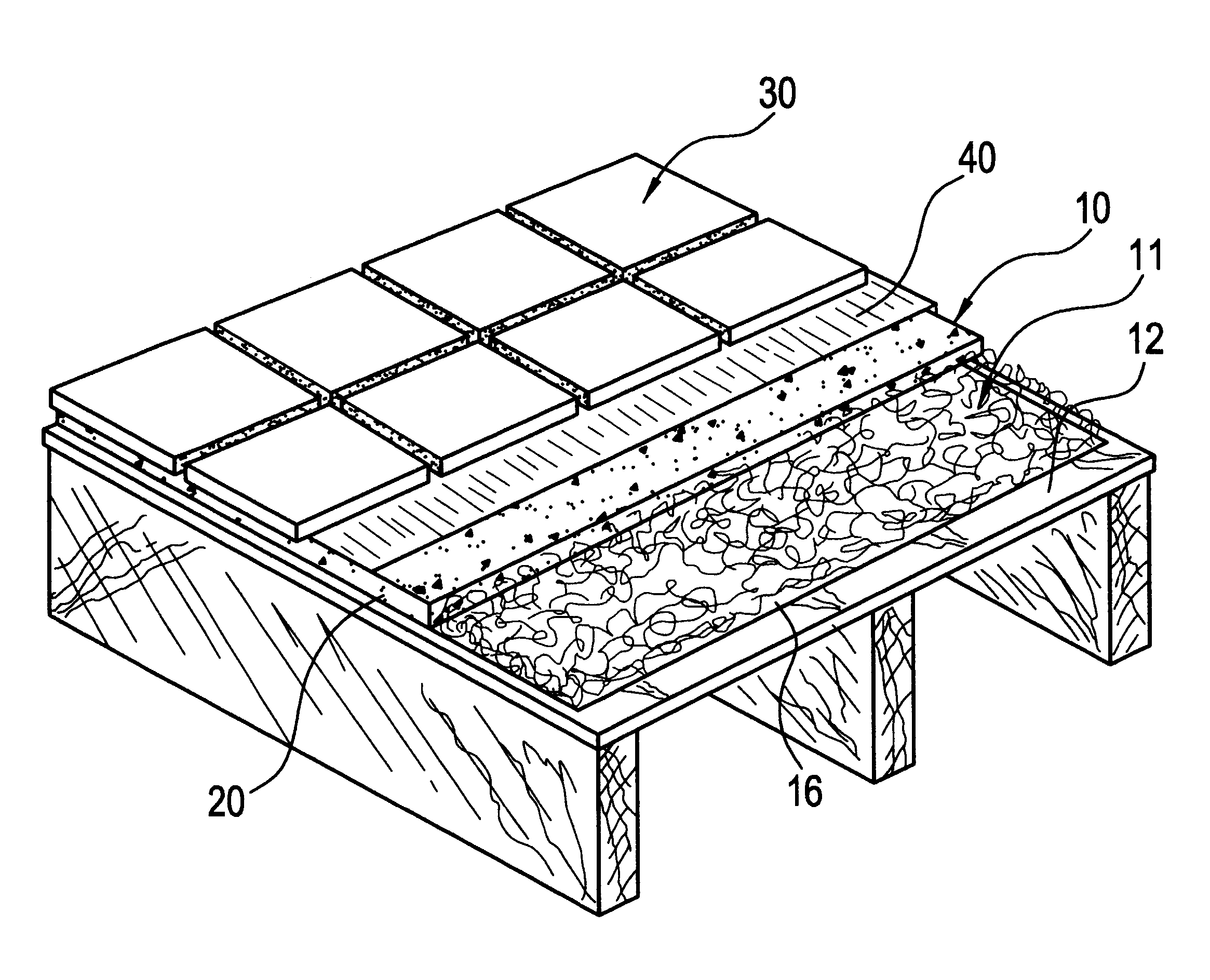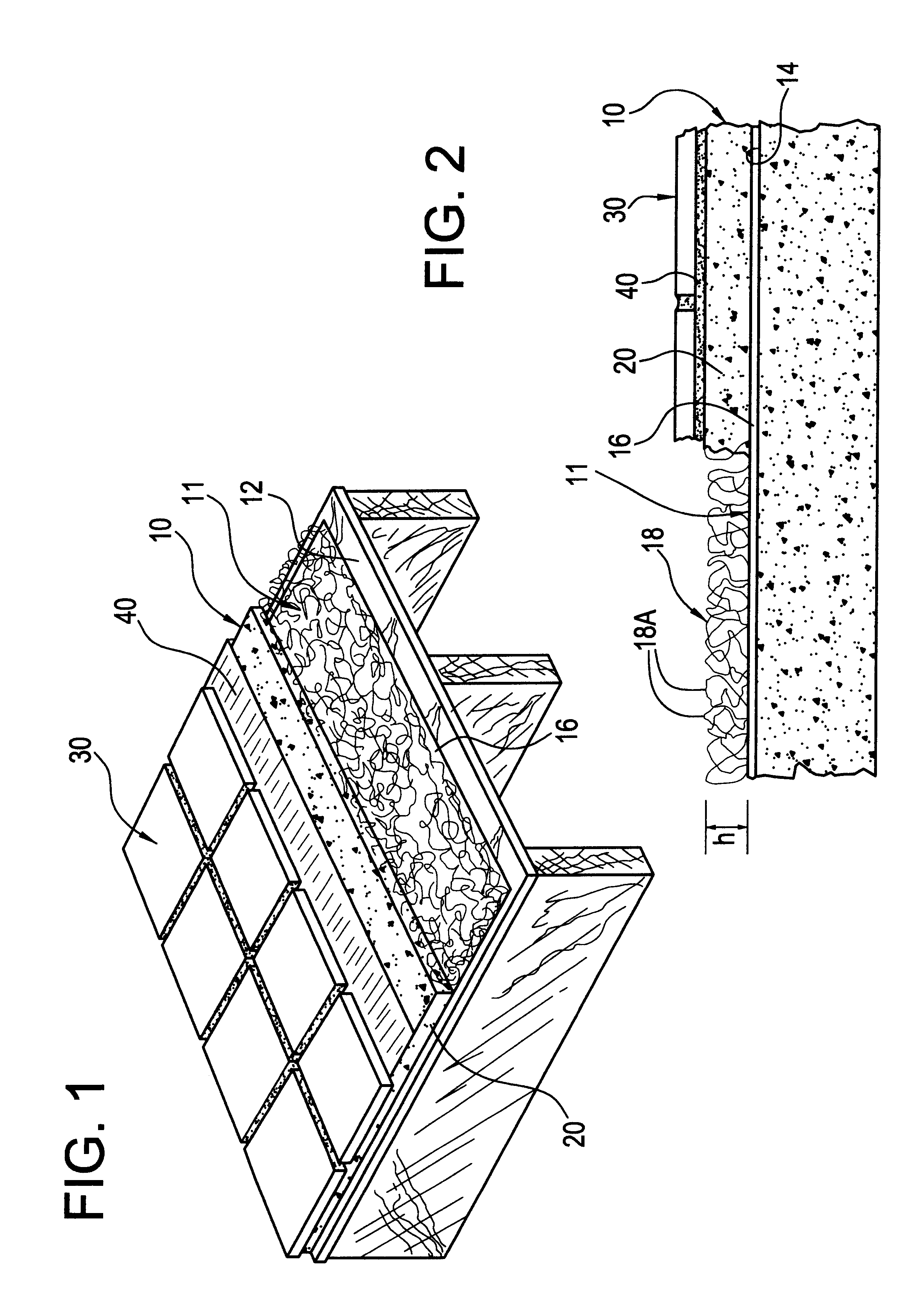Finished flooring underlayment and method of making same
a technology of finished flooring and underlayment, which is applied in the direction of resiliently-mounted floors, building repairs, water-setting substance layered products, etc., can solve the problems of wasting resources, consuming considerable time and labor, and reducing the service life of the floor,
- Summary
- Abstract
- Description
- Claims
- Application Information
AI Technical Summary
Benefits of technology
Problems solved by technology
Method used
Image
Examples
example 1
A floor was assembled according to the following method. A layer of 5 / 8 inch thick plywood was assembled on 16 inch on-center joists. The joists were 1.5 inches wide by 2.25 inches high. The plywood sheets were nailed to the joist system 6 inches on-center along the edges and 8 inches on-center in the field of the panel. 8d ring shank nails were used.
A 0.7 inch thick plastic mat having bonded plastic filaments was stapled to the plywood. A mortar of Formula II type was mixed with water to a high slump consistency. The mortar was placed by spreading it into the mat with a flat trowel and then leveling it off to smooth it with a straight edge.
The underlayment was allowed to cure 28 days.
12 inch.times.12 inch.times.1 / 4 inch marble was adhered to the cured underlayment with a latex fortified cementicious adhesive.
The marble was grouted with a latex fortified cementicious unsanded grout.
A Robinson Floor Test was run on the completed installation according to ASTM C-627. There was grout c...
example 2
A 2 inch thick concrete slab was made with commercially available concrete mix. The slab was allowed to cure 3 days. Then a 0.4 inch thick plastic mat having bonded nylon filaments was adhered to the concrete using a mastic type tile adhesive. A seam was placed in the middle of the slab. A latex fortified mortar similar to Formula II was mixed to a high slump consistency. The mortar was placed by spreading it into the mat with a flat trowel and leveling it. The underlayment was allowed to cure overnight. 12 inch.times.12 inch.times.3 / 8 inch porcelain tile was adhered to the underlayment using a latex fortified thinset adhesive. The tile adhesive was allowed to cure overnight. The tile was then grouted with a latex fortified sanded grout.
The underlayment mortar was allowed to cure 28 days. The adhesive mortar cured 27 days and the grout cured 26 days.
A Robinson Floor Test was run on the system according to ASTM C-627. The test went 14 cycles with no failure. The Tile Council of Ameri...
example 3
A floor was assembled according to the following method. A layer of 3 / 4 inch thick tongue and groove oriented strand board was assembled on 24 inch on center joists. A tongue and groove seam was placed at 1 foot in on the test machine such that the seam was in the wheel path. The joists were 1.5 inches wide by 2.25 inches high. The sheet were nailed to the stud system 6 inches on center along the edges and 8 inches on center in the field of the panel. 8d ring shank nails were used.
A 0.7 inch thick plastic mat having bonded plastic filaments was stapled to the plywood. A mortar of Formula II type was mixed with water to a high slump consistency. The mortar was placed by spreading it into the mat with a flat trowel and then leveling it with a straight edge. The tile was 12 inch.times.12 inch 3 / 8 inch porcelain tile and was adhered to the underlayment using a latex fortified thinset adhesive. The tile adhesive was allowed to cure overnight. The tile was then grouted with a latex fortif...
PUM
| Property | Measurement | Unit |
|---|---|---|
| thick | aaaaa | aaaaa |
| thick | aaaaa | aaaaa |
| widths | aaaaa | aaaaa |
Abstract
Description
Claims
Application Information
 Login to View More
Login to View More - R&D
- Intellectual Property
- Life Sciences
- Materials
- Tech Scout
- Unparalleled Data Quality
- Higher Quality Content
- 60% Fewer Hallucinations
Browse by: Latest US Patents, China's latest patents, Technical Efficacy Thesaurus, Application Domain, Technology Topic, Popular Technical Reports.
© 2025 PatSnap. All rights reserved.Legal|Privacy policy|Modern Slavery Act Transparency Statement|Sitemap|About US| Contact US: help@patsnap.com


